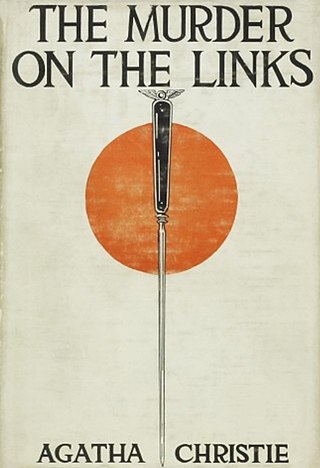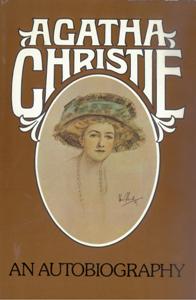
Dame Agatha Mary Clarissa Christie, Lady Mallowan, was an English writer known for her 66 detective novels and 14 short story collections, particularly those revolving around fictional detectives Hercule Poirot and Miss Marple. She also wrote the world's longest-running play, the murder mystery The Mousetrap, which has been performed in the West End of London since 1952. A writer during the "Golden Age of Detective Fiction", Christie has been called the "Queen of Crime". She also wrote six novels under the pseudonym Mary Westmacott. In 1971, she was made a Dame (DBE) by Queen Elizabeth II for her contributions to literature. Guinness World Records lists Christie as the best-selling fiction writer of all time, her novels having sold more than two billion copies.

Death in the Clouds is a work of detective fiction by British writer Agatha Christie, published in 1935. It features the Belgian detective Hercule Poirot and Chief Inspector Japp. It is a "closed circle" murder mystery: the victim is a passenger on a cross-Channel aircraft flight, and the perpetrator can only be one of eleven fellow-passengers and crew.

Lord Edgware Dies is a work of detective fiction by British writer Agatha Christie, published in the UK by the Collins Crime Club in September 1933 and in the US by Dodd, Mead and Company later in the same year under the title of Thirteen at Dinner. Before its book publication, the novel was serialised in six issues of The American Magazine as 13 For Dinner.

The Murder on the Links is a work of detective fiction by Agatha Christie, first published in the US by Dodd, Mead & Co in March 1923, and in the UK by The Bodley Head in May of the same year. It is the second novel featuring Hercule Poirot and Arthur Hastings. The UK edition retailed at seven shillings and sixpence (7/6), and the US edition at $1.75.

Peril at End House is a work of detective fiction by British writer Agatha Christie, first published in the US by the Dodd, Mead and Company in February 1932 and in the UK by the Collins Crime Club in March of the same year. The US edition retailed at $2.00 and the UK edition at seven shillings and sixpence (7/6).

The Secret of Chimneys is a work of detective fiction by British writer Agatha Christie, first published in the UK by The Bodley Head in June 1925 and in the US by Dodd, Mead and Company later in the same year. It introduces the characters of Superintendent Battle and Lady Eileen "Bundle" Brent. The UK edition retailed at seven shillings and sixpence (7/6) and the US edition at $2.00.

At Bertram's Hotel is a work of detective fiction by Agatha Christie and first published in the UK by the Collins Crime Club on 15 November 1965 and in the US by Dodd, Mead and Company the following year. The UK edition retailed at sixteen shillings (16/-) and the US edition at $4.50. It features the detective Miss Marple staying at an upmarket hotel which is at the centre of a mysterious disappearance.

The Mystery of the Blue Train is a work of detective fiction by British writer Agatha Christie, first published in the United Kingdom by William Collins & Sons on 29 March 1928 and in the United States by Dodd, Mead and Company later in the same year. The UK edition retailed at seven shillings and sixpence (7/6) and the US edition at $2.00. The book features her detective Hercule Poirot.

The Man in the Brown Suit is a work of detective fiction by British writer Agatha Christie, first published in the UK by The Bodley Head on 22 August 1924 and in the US by Dodd, Mead and Company later in the same year. The character Colonel Race is introduced in this novel.

The Sittaford Mystery is a work of detective fiction by British writer Agatha Christie, first published in the US by Dodd, Mead and Company in 1931 under the title of The Murder at Hazelmoor and in UK by the Collins Crime Club on 7 September of the same year under Christie's original title. It is the first Christie novel to be given a different title for the US market. The US edition retailed at $2.00 and the UK edition at seven shillings and sixpence (7/6).

They Came to Baghdad is an adventure novel by Agatha Christie, first published in the United Kingdom by the Collins Crime Club on 5 March 1951 and in the United States by Dodd, Mead and Company later in the same year. The UK edition retailed at eight shillings and sixpence (8/6) and the US edition at $2.50.

A Daughter's a Daughter is a novel written by Agatha Christie and first published in the UK by Heinemann on 24 November 1952. Initially unpublished in the US, it was later issued as a paperback by Dell Publishing in September 1963. It was the fifth of six novels Christie wrote under the nom-de-plume Mary Westmacott. Initially a play written by Christie in the late 1930s, the plot tells of a daughter's opposition to her mother's plan to remarry.

The Burden is a novel written by Agatha Christie and first published in the UK by Heinemann on 12 November 1956. Initially not published in the US, it was later issued as a paperback by Dell Publishing in September 1963. It was the last of six novels Christie wrote under the nom-de-plume Mary Westmacott.

Akhnaton is a play by Agatha Christie. It was written in 1937, around the same time she was writing Death on the Nile. It is set in Ancient Egypt, and followed the exploits of the Egyptian Pharaoh Akhnaton, his wife Nefertiti and his successor Tutankhaton. In writing the play, Christie was assisted by the eminent Egyptologist, Stephen Glanville, who was a friend of both her and her husband, Max Mallowan.

Sir Max Edgar Lucien Mallowan was a prominent British archaeologist, specialising in ancient Middle Eastern history. He was the second husband of Dame Agatha Christie.

And Then There Were None is a 1943 play by crime writer Agatha Christie. The play, like the 1939 book on which it is based, was originally titled and performed in the UK as Ten Little Niggers. It was also performed under the name Ten Little Indians.

Three Blind Mice is the name of a half-hour radio play written by Agatha Christie, which was later adapted into a television film, a short story, and a popular stage production.

Poems is the second of two collections of poetry by crime writer Agatha Christie, the first being The Road of Dreams in January 1925. It was published in October 1973 at the same time as the novel Postern of Fate, the final work she ever wrote.

Come, Tell Me How You Live is a short book of autobiography and travel literature by crime writer Agatha Christie. It is one of only two books she wrote and had published under both of her married names of "Christie" and "Mallowan" and was first published in the UK in November 1946 by William Collins and Sons and in the same year in the US by Dodd, Mead and Company. The UK edition retailed for ten shillings and sixpence (10/6) and the US edition at $3.00.

Agatha Christie (1890–1976) was an English crime novelist, short-story writer and playwright. Her reputation rests on 66 detective novels and 15 short-story collections that have sold over two billion copies, an amount surpassed only by the Bible and the works of William Shakespeare. She is also the most translated individual author in the world with her books having been translated into more than 100 languages. Her works contain several regular characters with whom the public became familiar, including Hercule Poirot, Miss Marple, Tommy and Tuppence Beresford, Parker Pyne and Harley Quin. Christie wrote more Poirot stories than any of the others, even though she thought the character to be "rather insufferable". Following the publication of the 1975 novel Curtain, Poirot's obituary appeared on the front page of The New York Times.



















